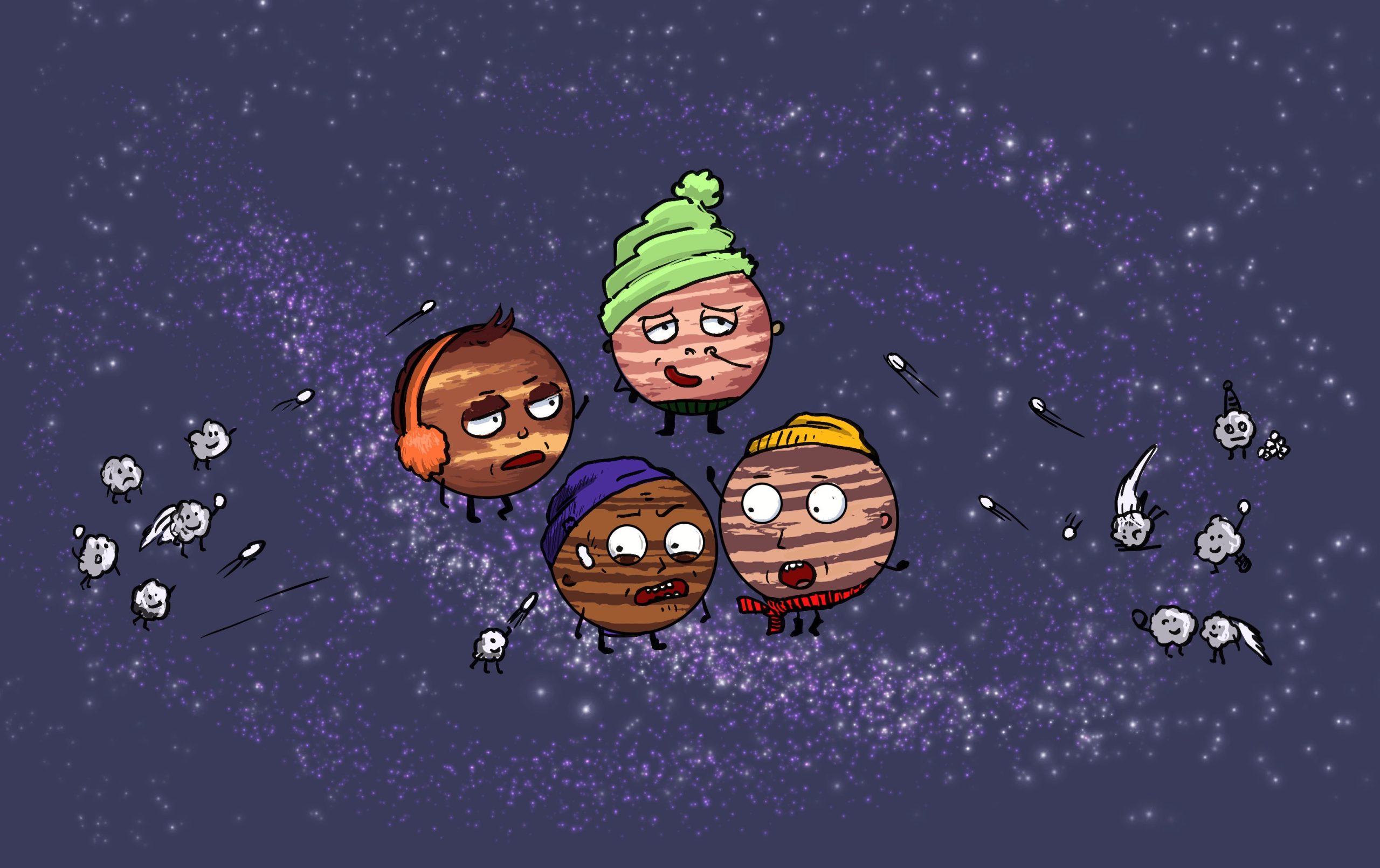(English follows Dutch)
Het planetenstelsel rond de ster HR8799 lijkt opmerkelijk veel op ons eigen Zonnestelsel. Het heeft vier gasreuzen tussen twee asteroïdegordels. Onderzoekers van de RuG en SRON hebben deze gelijkenis gebruikt om de aanvoer te simuleren van materiaal afkomstig van asteroïden, kometen en andere kleine hemellichamen. De simulatie laat zien dat de vier gasplaneten materiaal ontvangen van kleine hemellichamen, net als in ons Zonnestelsel.

Vanaf de Zon geteld heeft ons Zonnestelsel vier rotsachtige planeten, een asteroïdegordel, vier gasreuzen en nog een asteroïdegordel. De binnenste planeten zijn rijk aan vuurvaste materialen zoals metalen en silicaten, de buitenste hebben juist veel vluchtige stoffen zoals water en methaan. Tijdens het vormingsproces hadden de binnenplaneten het moeilijk om een vluchtige atmosfeer te verzamelen omdat de sterke zonnewind het gas steeds wegblies. Tegelijkertijd verdampte elk ijsklontje door de warmte van de Zon, wat het lastig maakte om water vast te houden. In de buitenste regionen was er minder zonnewind en -warmte, zodat de uiteindelijke gasreuzen waterijs konden verzamelen en ook een grote atmosfeer vol vluchtige stoffen konden opbouwen.
Kleine hemellichamen, waaronder asteroïden, kometen en stof, hebben deze uitkomst later verfijnd door vuurvaste materialen uit de binnenste gordel af te leveren en vanuit de buitenste gordel zowel vluchtige als vuurvaste stoffen. Een team van astronomen onder leiding van de Rijksuniversiteit Groningen en SRON Netherlands Institute for Space Research vroeg zich af of planetenstelsels rond andere sterren ook zo’n aanvoersysteem hebben. Ze bouwden een simulatie voor het stelsel rond HR8799. Dat lijkt sterk op ons eigen Zonnestelsel met vier gasreuzen en een binnen- en buitengordel, en mogelijk rotsachtige planeten binnen de binnengordel. Daarom kon het team een aantal onbekende factoren voor HR8799 adopteren vanuit ons Zonnestelsel.
De simulatie laat zien dat net als in ons Zonnestelsel de vier gasreuzen materiaal krijgen aangeleverd via kleine hemellichamen. Het team, bestaande uit Kateryna Frantseva (Rijksuniversiteit Groningen/SRON), Migo Mueller (NOVA/Universiteit Leiden/SRON), Petr Pokorný (NASA), Floris van der Tak (SRON/Rijksuniversiteit Groningen) en Inge Loes ten Kate (Universiteit Utrecht), voorspelt een totale aanvoer van beide typen materiaal van ongeveer een half miljoenste van de planeetmassa’s. Toekomstige telescopen—bijvoorbeeld NASA’s James Webb Space Telescope (lancering in 2021)—zijn in staat om de hoeveelheden vuurvaste materialen te meten in de gasreuzen, die rijk zijn aan vluchtige stoffen. Frantseva: ‘Als telescopen de voorspelde hoeveelheden vuurvaste stoffen detecteren, verklaren we die door aanvoer vanuit de gordels, zoals onze simulatie laat zien. Als ze meer vuurvaste stoffen detecteren dan voorspeld, dan is het aanvoerproces misschien actiever dan we dachten, bijvoorbeeld omdat HR8799 veel jonger is dan ons Zonnestelsel. Het HR8799-systeem bevat mogelijk aardachtige planeten. De aanvoer van vluchtige stoffen vanuit de asteroïdegordels kan daarvoor astrobiologisch gezien relevant zijn.’
Publicatie
K. Frantseva, M. Mueller, P. Pokorný, F. F.S. van der Tak, I. L. ten Kate, ‘Enrichment of the HR 8799 planets by minor bodies and dust‘, Astronomy & Astrophysics
Astronomers predict bombardment from asteroids and comets in other planetary system
The planetary system around star HR8799 is remarkably similar to our Solar System. It has four gas giants in between two asteroid belts. A research team led by RuG and SRON used this similarity to model the delivery of materials by asteroids, comets and other minor bodies within the system. Their simulation shows that the four gas planets receive material delivered by minor bodies, just like in our Solar System.

Counting outwards from the Sun, our Solar System consists of four rocky planets, an asteroid belt, four gas giants and another asteroid belt. The inner planets are rich in refractory materials such as metals and silicates, the outer planets are rich in volatiles such as water and methane. While forming, the inner planets had a hard time collecting a volatile atmosphere because the strong solar wind kept blowing the gas away. At the same time the heat from the Sun evaporated any ice clumps, so it was harder to retain water. In the outer regions, there was less solar heat and wind, so the eventual gas giants could collect water ice and also gather large atmospheres filled with volatiles.
Minor bodies, including asteroids, comets and dust, fine-tuned this outcome later on by delivering refractories from the inner belt and both volatiles and refractories from the outer belt. A team of astronomers led by Rijksuniversiteit Groningen and SRON Netherlands Institute for Space Research wondered if the same delivery system applies to planetary systems around other stars. They created a simulation for the system around HR8799. That is similar to our Solar System with four gas giants plus an inner and outer belt, and possibly rocky planets inside the inner belt. Therefore the team could adopt some unknowns about HR8799 from our own Solar System.
The simulation shows that just like in our Solar System, the four gas planets receive material delivered by minor bodies. The team of scientists, consisting of Kateryna Frantseva (University of Groningen/SRON), Migo Mueller (NOVA/Leiden University/SRON), Petr Pokorný (NASA), Floris van der Tak (SRON/University of Groningen) and Inge Loes ten Kate (Utrecht University), predict a total delivery of both material types of around half a millionth of the planets’ masses. Future observations, for example by NASA’s James Webb Space Telescope (launch in 2021), will be able to measure the amount of refractories in the volatile-rich gas giants. Frantseva: ‘If telescopes will detect the predicted amount of refractories, we say that these detected refractories can be explained by delivery from the belts as shown in our model. If they detect more refractories than predicted, we say that maybe the delivery process is more active that we thought, for example because HR8799 is much younger than the Solar System. The HR8799 system may contain terrestrial planets. Volatile delivery from the asteroid belts may be of astrobiological relevance for those.’
Publication
K. Frantseva, M. Mueller, P. Pokorný, F. F.S. van der Tak, I. L. ten Kate, ‘Enrichment of the HR 8799 planets by minor bodies and dust‘, Astronomy & Astrophysics


